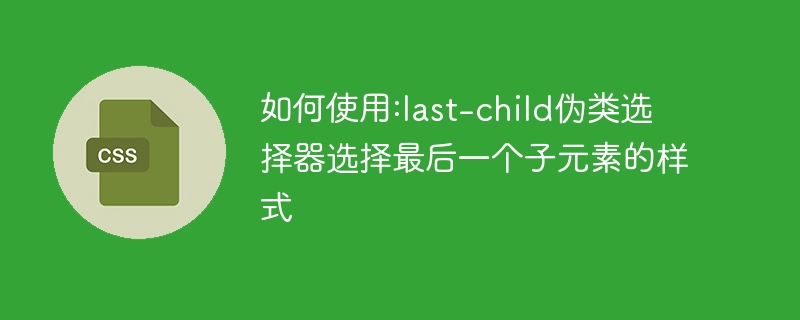

How to use:last-child pseudo-class selector to select the style of the last child element, you need specific code examples
In CSS, there are many pseudo-class selectors Can be used to select different element types. One of the most commonly used and practical pseudo-class selectors is :last-child. Use the :last-child pseudo-class selector to select the last child element in the parent element and apply a specific style to it. The following will explain in detail how to use the :last-child pseudo-class selector and provide specific code examples.
First, let us understand the basic syntax and usage of the :last-child pseudo-class selector. The :last-child selector can be used to select the last child element in the parent element. For example, if there are multiple child elements in a parent element, we can use the :last-child pseudo-class selector to select the last child element and add styles to it. The following is the basic syntax of the last-child pseudo-class selector:
Parent element: last-child {
/* 添加样式 */
}
Next, let us pass a specific Example to illustrate how to use the :last-child pseudo-class selector. Suppose we have an HTML structure that looks like this:
<div class="parent">
<span>第一个子元素</span>
<span>第二个子元素</span>
<span>第三个子元素</span>
<span>最后一个子元素</span>
</div>Now, we want to select the last child element within the parent element and add a specific style to it. We can use the :last-child pseudo-class selector to achieve this effect. The following is a specific CSS code example:
.parent span:last-child {
color: red;
font-weight: bold;
} In the above code example, we use the .parent span:last-child selector to select .parent The last span child element in the element and apply a red color and bold font style to it. This way, the last child element within the parent element will become red and bold.
In addition, in order to better understand and demonstrate the use of the last-child pseudo-class selector, we can also add different styles to different child elements of the parent element. For example, we can add normal styles to the first three child elements and highlight styles to the last child element. The following is a specific CSS code example:
.parent span:not(:last-child) {
color: blue;
}
.parent span:last-child {
color: red;
font-weight: bold;
}In the above code example, the :not(:last-child) selector is used to select except the last child in the .parent element All child elements outside the element and apply a style with color blue to them. At the same time, the .parent span:last-child selector is used to select the last span child element in the .parent element and apply the color to it. Red, bold font style.
In summary, by using the :last-child pseudo-class selector, we can easily select the last child element in the parent element and add a specific style to it. Whether you are selecting a single element or adding different styles to multiple child elements in the parent element, you can use the :last-child pseudo-class selector. I hope this article can help you understand and use the :last-child pseudo-class selector, and provide help for your web design.
The above is the detailed content of How to use the :last-child pseudo-class selector to select the style of the last child element. For more information, please follow other related articles on the PHP Chinese website!
 How to use blockquote tag
How to use blockquote tag
 setinterval usage
setinterval usage
 what does usb interface mean
what does usb interface mean
 What are the advantages and disadvantages of decentralization
What are the advantages and disadvantages of decentralization
 How to use the axis function in Matlab
How to use the axis function in Matlab
 Solution to the problem that win7 system cannot start
Solution to the problem that win7 system cannot start
 How to write html text box code
How to write html text box code
 The phone cannot connect to the Bluetooth headset
The phone cannot connect to the Bluetooth headset
 What does web server mean?
What does web server mean?




